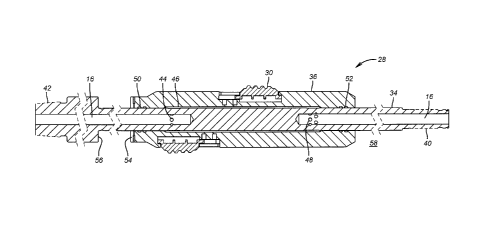Some of the information on this Web page has been provided by external sources. The Government of Canada is not responsible for the accuracy, reliability or currency of the information supplied by external sources. Users wishing to rely upon this information should consult directly with the source of the information. Content provided by external sources is not subject to official languages, privacy and accessibility requirements.
Any discrepancies in the text and image of the Claims and Abstract are due to differing posting times. Text of the Claims and Abstract are posted:
| (12) Patent Application: | (11) CA 3025106 |
|---|---|
| (54) English Title: | DIVERTER VALVE FOR A BOTTOM HOLE ASSEMBLY |
| (54) French Title: | VANNE DE DERIVATION DESTINEE A UN ASSEMBLAGE DE FOND DE TROU |
| Status: | Allowed |
| (51) International Patent Classification (IPC): |
|
|---|---|
| (72) Inventors : |
|
| (73) Owners : |
|
| (71) Applicants : |
|
| (74) Agent: | MARKS & CLERK |
| (74) Associate agent: | |
| (45) Issued: | |
| (22) Filed Date: | 2018-11-23 |
| (41) Open to Public Inspection: | 2019-05-29 |
| Examination requested: | 2022-06-01 |
| Availability of licence: | N/A |
| (25) Language of filing: | English |
| Patent Cooperation Treaty (PCT): | No |
|---|
| (30) Application Priority Data: | ||||||
|---|---|---|---|---|---|---|
|
A bottom hole assembly (BHA) incorporates a tubular cutter driven by a
downhole
motor. A scraper moves into a smaller tubular to clean an area where a spear
will later be
engaged to the cut tubular portion. The scraper has a relatively movable
mandrel that allows
straight through flow into the motor or closes flow to build pressure to a
telescoping jack to exert
a pull force on the cut tubular after the cut is made. The spear is
articulated with mandrel
manipulation to grab the cut segment and weight is set down to shift the
mandrel in the scraper
to allow pressure buildup with rig pumps turned on to retract the jack as the
BHA is held with
anchors in the larger tubular. The cut segment is pulled uphole to loosen it
so it can be removed
from the borehole.
Note: Claims are shown in the official language in which they were submitted.
Note: Descriptions are shown in the official language in which they were submitted.

For a clearer understanding of the status of the application/patent presented on this page, the site Disclaimer , as well as the definitions for Patent , Administrative Status , Maintenance Fee and Payment History should be consulted.
| Title | Date |
|---|---|
| Forecasted Issue Date | Unavailable |
| (22) Filed | 2018-11-23 |
| (41) Open to Public Inspection | 2019-05-29 |
| Examination Requested | 2022-06-01 |
There is no abandonment history.
Last Payment of $210.51 was received on 2023-10-19
Upcoming maintenance fee amounts
| Description | Date | Amount |
|---|---|---|
| Next Payment if small entity fee | 2024-11-25 | $100.00 |
| Next Payment if standard fee | 2024-11-25 | $277.00 |
Note : If the full payment has not been received on or before the date indicated, a further fee may be required which may be one of the following
Patent fees are adjusted on the 1st of January every year. The amounts above are the current amounts if received by December 31 of the current year.
Please refer to the CIPO
Patent Fees
web page to see all current fee amounts.
| Fee Type | Anniversary Year | Due Date | Amount Paid | Paid Date |
|---|---|---|---|---|
| Registration of a document - section 124 | $100.00 | 2018-11-23 | ||
| Application Fee | $400.00 | 2018-11-23 | ||
| Maintenance Fee - Application - New Act | 2 | 2020-11-23 | $100.00 | 2020-10-22 |
| Maintenance Fee - Application - New Act | 3 | 2021-11-23 | $100.00 | 2021-10-20 |
| Request for Examination | 2023-11-23 | $814.37 | 2022-06-01 | |
| Maintenance Fee - Application - New Act | 4 | 2022-11-23 | $100.00 | 2022-10-24 |
| Maintenance Fee - Application - New Act | 5 | 2023-11-23 | $210.51 | 2023-10-19 |
Note: Records showing the ownership history in alphabetical order.
| Current Owners on Record |
|---|
| BAKER HUGHES, A GE COMPANY, LLC |
| Past Owners on Record |
|---|
| None |